At midnight, the room lights came on, awakening Lt. Herb Altman and the crew of the B-17G bomber, Bouncin’ Baby. “How much gas today?” was everyone’s first question. The fuel tanks, they soon saw, were full. Such topped-off tanks, suitable for a deep raid, probably meant a specific destination. “Big B, sure as hell,” everyone thought.
The Big B was Berlin, capital of the Third Reach and pride of the Fuehrer. In World War II’s hard-fought bomber war, Berlin was in some ways the ultimate target. It wasn’t as far away as Ploesti, nor as heavily defended as Leuna. However, for sheer political significance, Berlin could not be matched.
“This was Hitler’s town,” noted one B-17 gunner. In the words of the Air Chief Marshal Arthur T. Harris, head of the RAF’s Bomber Command, “It was the target which above all the Luftwaffe was bound to defend.”
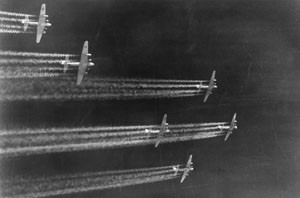 |
During WWII, USAAF B-17s leave vapor trails over Germany. |
Berlin would remain throughout the war a difficult technical and operational challenge for Allied airmen.
First to bomb the German capital were the French, mounting a small raid on June 7, 1940 as French lines were collapsing under the weight of the Nazi blitzkrieg.
However, serious attacks on Hitler’s capital had to wait until the technology of airpower sufficiently matured. It would take the mass production of new aircraft such as the RAF’s four-engine Lancaster bomber and the American P-51 long-range escort to make attacks on Berlin effective. And the US Army Air Forces’ daylight attacks on Berlin did not begin until March 4, 1944.
The assault on Berlin had four main phases, beginning with the RAF strikes on the capital that changed the course of the Battle of Britain.
The bombing of Berlin began with a mistake—a Luftwaffe mistake. On the night of Aug. 23, 1940, a segment of a German bombing formation that had been dispatched to strike at aircraft factories and oil tanks outside London drifted off course and launched a ferocious attack on the English capital itself.
Britain’s new Prime Minister, Winston S. Churchill, was only too happy to use the incident as an incentive to remind Hitler about British will power. “The War Cabinet were much in the mood to hit back, to raise the stakes, and to defy the enemy,” Churchill later wrote. “I was sure they were right.”
The British counterattack itself was hampered by limited range of its bombers. A force of 81 RAF bombers hit Berlin on the night of Aug. 25, 1940. Clouds covered the target and the bombing itself amounted to a series of pinpricks.
Still, the psychological effect was enormous. The American journalist William L. Shirer, who was then broadcasting from Berlin on the CBS radio network, saw the flash of the searchlights and “the terrific din of the flak.” Three days later, when the RAF launched a stronger attack, “the Nazi bigwigs were outraged,” Shirer wrote in his diary. That is because they knew that, for all the success of Germany’s armies, the war was not over.
The bombing of Berlin “spread great disillusionment,” reported Shirer. The Nazi leadership, including Luftwaffe chief Hermann W. Goering, did not think it could ever happen. In fact, said Shirer, “Goering assured them it wouldn’t.”
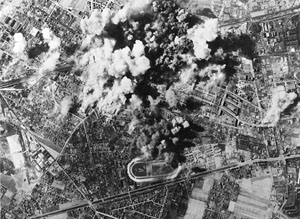 |
Smoke plumes rise in the aftermath of a B-17 raid on the Daimler-Benz tank works, Berlin, in March 1945. |
Fitful Attacks
On Sept. 4, 1940, Hitler announced his plan for retaliation. “When they declare that they will increase their attacks on our cities, then we will raze their cities to the ground,” Hitler said. The fateful decision took pressure off the beleaguered airfields and forces of the RAF, and none too soon. The shift to attacks on London ended the Luftwaffe’s best chance to prevail in the Battle of Britain.
London, however, paid the price. Between Sept. 7 and Nov. 3, the city absorbed the force of almost daily bomber attacks, raids that left the ancient English city aflame in many areas.
Well into 1941, RAF Bomber Command could mount only fitful counterattacks, with scant result. One such raid against Berlin in late 1941 led to the loss of 20 bombers (out of 160 in the formation) and brought about the sacking of Air Marshal Richard E.C. Peirse as the head of Bomber Command.
Things were different—very different—after Harris took command. He bided his time. The pinprick attacks halted while Harris dealt with other targets such as German U-boat facilities and, more important, waited for more four-engine Lancaster bombers. During all of 1942, there were only nine air raid alerts in the Reich capital.
The reason was tactical. Berlin was a city of four million, and its built-up zones sprawled across 18,000 acres. According to Harris, “No noticeable impression could be made on it except by a strong force of heavy bombers.” He resisted pressure to attack Berlin until the RAF was ready.
In early 1943, Harris had a force sufficient to restart probing attacks. From January through March, he sent Lancasters and other bombers to attack Berlin. Snow and haze affected bomb aiming and, on moonlit nights, Luftwaffe night fighters mauled the bomber stream. Twenty-two bombers were lost on one night in January 1943.
Still, Bomber Command advanced. The RAF under Harris successfully applied radar bombing techniques and even tried a night low-level attack with swift, wooden Mosquito bombers. Overall the RAF sustained 4.6 percent attrition between January and March 1943, which Harris viewed as “light, considering the target.”
The RAF kept up the sporadic raids until the lengthening days of spring made it impossible for crews to complete a full round-trip journey under cover of darkness.
After the RAF destroyed downtown Hamburg in a firestorm in July 1943, Harris tried the same tactic on Berlin. RAF bombers flew 1,647 sorties in three mass attacks in a 10-day period in late August. The biggest single attack on Berlin to that point came on Aug. 23, 1943, when 727 RAF bombers attacked.
However, Harris was not yet free to concentrate on Berlin. The RAF was alternating the strikes on Berlin with priority attacks on V-1 “buzz bomb” facilities and other targets.
The true “Battle of Berlin” began on Nov. 18, 1943. In some 16 raids (through February 1944) the RAF attempted to deal German industry and morale a knockout blow.
More than 400 Lancasters, led by a few intrepid Mosquitos, attacked the city in a stream. The bombers marshaled, then proceeded to their targets. Pathfinder aircraft marked the target area, often with the help of radar navigation and bombing aids, which were best at painting coastal contrast and built-up city areas.
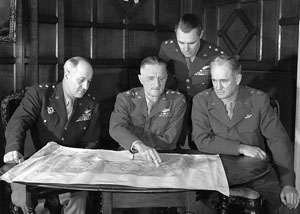 |
The commander of US Stategic Forces in Europe, Lt. Gen. Carl Spaatz (center), Maj. Gen. Ralph Royce (left), Maj. Gen. Hoyt Vandenberg (standing), and Maj. Gen. Hugh Knerr (right) pore over a target map.
|
Shaken, Not Stirred
Intense attacks followed on the night of Nov. 22-23, 1943. More than 2,300 tons of bombs hit across the city, destroying everything from the former British Embassy to the Waffen SS Administrative College.
Reich armaments minister Albert Speer was in his office when the air raid warning sounded. Excited to witness the attack, he drove to a nearby flak tower. “But I scarcely reached the top of the tower when I had to take shelter inside it; in spite of the tower’s stout concrete walls, heavy hits nearby were shaking it,” Speer later recorded.
When the raid ended, Speer ventured out onto the tower to see his nearby Ministry ablaze in “one gigantic conflagration.” His private office was now a bomb crater.
The Berlin raids gave warning that the Allies were extending their fighter cover. Speer told of an exchange between Goering and the Luftwaffe fighter commander, Adolf Galland. The latter told the Nazi air chief that American fighters had made it as far as Aachen, inside of German airspace. An incredulous Goering refused to believe it.
“Herr Reichsmarschall,” Galland replied, “they will soon be flying even deeper.”
The Big B soon began to take a toll on Bomber Command. By December 1943, nine percent of the force was nonoperational for re-equipping, due to combat losses. Harris expected losses. About 500 aircraft failed to return from raids between November 1943 and March 1944.
This represented an average loss rate of 6.2 percent, which Harris said “could not be regarded as excessive in relation to the magnitude of the task.”
Unfortunately, operational results of the RAF’s Battle of Berlin were a disappointment. Berlin was Bomber Command’s most important target, but one of the most difficult to crack.
For one thing, Berlin’s size and lack of radar-visible landmarks forced the RAF to rely on blind skymarking, usually over full clouds, which also eliminated night photoreconnaissance.
Weather was “invariably poor on all 16 occasions,” admitted Harris. Churchill grumbled that good aerial photographs were not obtained until March.
Harris tallied 2,180 gross acres of devastation, mostly in the western half of the city. The Daimler-Benz, BMW, and Siemens factories producing tanks, engines, and other war materiel were all damaged in the night bombing, but shorter spring nights and new priorities forced the RAF to lay off the offensive.
The city had not been on the initial target list for American bombers because it lay so far beyond fighter escort range. But soon Berlin would be back on the list.
To Generals Henry H. “Hap” Arnold, Ira C. Eaker, and Carl A. Spaatz, daylight bombing was the only proven method for effective attack. Soon they all realized that good daylight bombing required three things: brave crews, good visibility at the target, and fighter escort.
Churchill was skeptical about daylight operations. In 1942, he had seen “many gallant and costly attacks” on occupied Europe firsthand and concluded that bombers, even in close formation, “could not fight their way in daylight through an efficient fighter defense without over-heavy casualties.”
It took an official directive from the Combined Chiefs of Staff—that top-ranking body of British and American military chiefs who made all major strategy decisions for the Allies in the war—to sanction American daylight precision bombing in February 1943 at Casablanca. In June, they clarified air war policy with the “Pointblank” directive in specifying destruction of the Luftwaffe as the most important near-term objective of the air war.
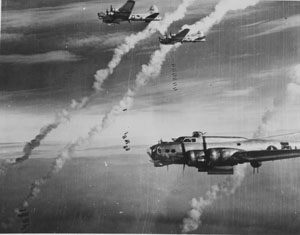 |
B-17s of Eighth Air Force drop bombs on Berlin in 1945.
|
Baiting the Luftwaffe
Fighter cover was still a problem—the Schweinfurt attack of Oct. 14, 1943 cost the USAAF 60 bombers out of a force of 291—an appalling loss rate of 20 percent. For the remainder of 1943, “daylight penetrations beyond fighter escort were sharply circumscribed,” noted the United States Strategic Bombing Survey, a massive compendium published after the war.
Preparation for the D-Day invasion and the arrival of the P-51 Mustang with wing tanks changed all that. The P-51 debuted in theater in December 1943. By March, its combat radius extended 850 miles with two 108-gallon drop tanks.
In mid-February 1944, a new directive went out to air commanders calling for: “Depletion of German Air Force with primary importance upon German fighter forces by all means available, including attacks against precision targets and industrial areas and facilities supporting them to create air situation favorable to Overlord.”
The USAAF went to Berlin to attack industrial targets, but also to bait German fighters into the air.
Three mass raids were carried out on March 4, March 6, and March 8, 1944. Each raid was planned “without any attempt at deception,” following a route to lure as many of the Luftwaffe fighter pilots into the skies as possible.
Poor weather disrupted the first attack. Only one bomber wing located Berlin in scattered clouds and bombed a Bosch plant under radar conditions. Little damage was done.
March 6, 1944 was a different story. Nearly 800 aircraft took off for the missions that day. More than 150 P-51 Mustangs met and escorted 660 bombers into the target area, where they dropped high explosives and incendiaries on industrial targets in good conditions.
Swarms of German fighters rose up to defend the Reich. Escort relays provided continuous fighter cover but could not prevent the loss of 69 bombers to fighters and flak. Fifteen aircraft were lost by the 100th Bomb Group alone, contributing to its nickname “The Bloody Hundredth.”
Pilot C. B. Harper of the B-17 Buffalo Gal recalled how German fighters exploited a short gap in fighter coverage and struck his group head on, in pairs. Fifteen bombers fell in less than 10 minutes before escorting P-47s closed the gap. According to historian Donald L. Miller, half the B-17s that landed after the March 6 attack on Berlin came back with battle damage.
Still, the plan was working. As many as 400 Luftwaffe fighters took the bait, setting up a terrible duel over Berlin. The 4th Fighter Group described how Germans and Americans “dropped wing tanks like two boxers shedding robes at the sound of the gong.”
Eighth Air Force bombers returned to Berlin on March 8. Many crews from the same units had attacked just two days earlier. This time, visual bombing conditions were excellent. Fighter opposition was weaker and 462 bombers flying in “tight formations” hit their targets.
The three strikes on Berlin encouraged Spaatz to cable Arnold that while the “heavy air wastage” could not yet be calculated, he was “confident that the air battle is in our hands.” The attacks cost Luftwaffe fighter commander Galland, in the single month of March, 20 percent of his experienced pilots.
Poor weather closed in after one more raid. The spring of 1944 brought US and British concentration on new targets, especially those in soon-to-be-invaded France.
After the attacks on Berlin, daylight precision bombing was an established weapon of war. From the Allies’ perspective, the big air battles around the daylight bomber formations worked. Losses were sustainable, the targets were being hit effectively, and the Luftwaffe’s pilots and aircraft were slowly but surely being ground down.
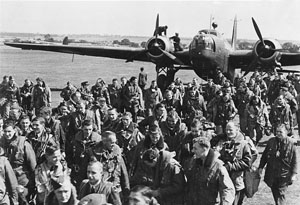 |
RAF aircrews return from a successful mission against Berlin, as mechanics swarm a bomber to ready it for another mission.
|
USAAF’s Biggest Raid
Even Churchill put to rest the “prolonged and obstinate technical argument” against daylight bombing.
The biggest USAAF raid on Berlin took place just a few months before the end of the war.
On Feb. 3, 1945, almost 1,000 American B-17s hit Berlin in clear weather. Bombardiers aiming from 24,000 to 27,000 feet scored good accuracy amidst “murderous” German flak. Just 21 bombers were lost as the P-51s kept away the tattered remnants of the Luftwaffe.
Although marshaling yards and railways were top targets, the list of additional targets had some interesting sites. The official USAAF history listed them as the Reichschancellery, Air Ministry, Foreign Office, Ministry of Propaganda, and Gestapo headquarters.
This raid cost Berliners between 20,000 and 25,000 dead. Then, the bomb lines moved inside Berlin as advancing armies shortened the lines of communication. The attacks on transportation facilities inside cities were coordinated with efforts to stop repositioning of troops as the Red Army pressed in. They were “missions which the Russians had requested and seemed to appreciate,” noted the USAAF official history.
The bombing of Berlin showed perhaps better than any other target how technical limits and campaign imperatives shaped the bomber war.
Looking back, the lens of history is smudged by brilliantly effective Nazi propaganda that recorded every attack in the most dramatic and graphic terms. It turned the bomber war against Germany into an ongoing debate scrutinized far more than bombings carried out by the Nazis earlier in the war ever were.
In part because of the efforts of Nazi propaganda minister Joseph Goebbels, tales of the bombing of the Reich and debate over its morality have lingered to this day. The analysis of the bombing tends to blend RAF and USAAF results with little distinction between the very different methods, motives, and objectives of the two air forces’ campaigns.
For the USAAF, bombing “Hitler’s town” always followed a campaign-level imperative—destroying the Luftwaffe, or wrecking ground lines of communication.
The RAF, threatened with destruction by the Luftwaffe as early as 1940, showed a different character. Statistics compiled by Harris demonstrate how hard the RAF pursued Berlin. RAF Bomber Command figured it had devastated 6,427 acres in Berlin. This damage was caused by 24 “main force” raids.
 |
The Berlin business district in July 1945, after the air raids had devastated the capital of Hitler’s Third Reich. |
It was the single highest acreage-devastation count of any European city in the war, although, owing to sprawling Berlin’s size, as a percentage the destruction was in the lowest quartile (33 percent destroyed).
The spread of destruction is better told by the statistic that 19,423 acres suffered at least 40 percent destruction at the hands of the RAF—a figure more than double acreage of the next highest city, Hamburg.
For their attacks on London, Churchill noted, the Germans were repaid “tenfold, twentyfold, in the frightful routine bombardment of German cities, which grew in intensity as our airpower developed, as the bombs became far heavier and the explosives more powerful. … Alas for poor humanity!”
Rebecca Grant is a contributing editor of Air Force Magazine. She is president of IRIS Independent Research in Washington, D.C., and has worked for RAND, the Secretary of the Air Force, and the Chief of Staff of the Air Force. Grant is a fellow of the Eaker Institute for Aerospace Concepts, the public policy and research arm of the Air Force Association. Her most recent article, “Vulnerability in Space,” appeared in the April issue.